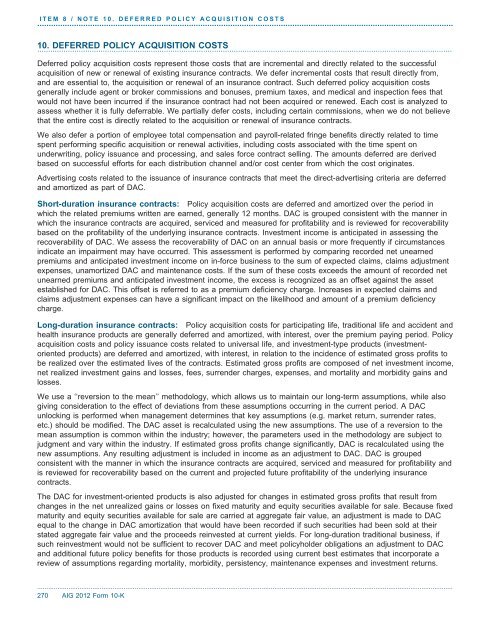Bring on tomorrow - AIG.com
Bring on tomorrow - AIG.com
Bring on tomorrow - AIG.com
Create successful ePaper yourself
Turn your PDF publications into a flip-book with our unique Google optimized e-Paper software.
ITEM 8 / NOTE 10. DEFERRED POLICY ACQUISITION COSTS.....................................................................................................................................................................................10. DEFERRED POLICY ACQUISITION COSTS..............................................................................................................................................................................................Deferred policy acquisiti<strong>on</strong> costs represent those costs that are incremental and directly related to the successfulacquisiti<strong>on</strong> of new or renewal of existing insurance c<strong>on</strong>tracts. We defer incremental costs that result directly from,and are essential to, the acquisiti<strong>on</strong> or renewal of an insurance c<strong>on</strong>tract. Such deferred policy acquisiti<strong>on</strong> costsgenerally include agent or broker <strong>com</strong>missi<strong>on</strong>s and b<strong>on</strong>uses, premium taxes, and medical and inspecti<strong>on</strong> fees thatwould not have been incurred if the insurance c<strong>on</strong>tract had not been acquired or renewed. Each cost is analyzed toassess whether it is fully deferrable. We partially defer costs, including certain <strong>com</strong>missi<strong>on</strong>s, when we do not believethat the entire cost is directly related to the acquisiti<strong>on</strong> or renewal of insurance c<strong>on</strong>tracts.We also defer a porti<strong>on</strong> of employee total <strong>com</strong>pensati<strong>on</strong> and payroll-related fringe benefits directly related to timespent performing specific acquisiti<strong>on</strong> or renewal activities, including costs associated with the time spent <strong>on</strong>underwriting, policy issuance and processing, and sales force c<strong>on</strong>tract selling. The amounts deferred are derivedbased <strong>on</strong> successful efforts for each distributi<strong>on</strong> channel and/or cost center from which the cost originates.Advertising costs related to the issuance of insurance c<strong>on</strong>tracts that meet the direct-advertising criteria are deferredand amortized as part of DAC.Short-durati<strong>on</strong> insurance c<strong>on</strong>tracts: Policy acquisiti<strong>on</strong> costs are deferred and amortized over the period inwhich the related premiums written are earned, generally 12 m<strong>on</strong>ths. DAC is grouped c<strong>on</strong>sistent with the manner inwhich the insurance c<strong>on</strong>tracts are acquired, serviced and measured for profitability and is reviewed for recoverabilitybased <strong>on</strong> the profitability of the underlying insurance c<strong>on</strong>tracts. Investment in<strong>com</strong>e is anticipated in assessing therecoverability of DAC. We assess the recoverability of DAC <strong>on</strong> an annual basis or more frequently if circumstancesindicate an impairment may have occurred. This assessment is performed by <strong>com</strong>paring recorded net unearnedpremiums and anticipated investment in<strong>com</strong>e <strong>on</strong> in-force business to the sum of expected claims, claims adjustmentexpenses, unamortized DAC and maintenance costs. If the sum of these costs exceeds the amount of recorded netunearned premiums and anticipated investment in<strong>com</strong>e, the excess is recognized as an offset against the assetestablished for DAC. This offset is referred to as a premium deficiency charge. Increases in expected claims andclaims adjustment expenses can have a significant impact <strong>on</strong> the likelihood and amount of a premium deficiencycharge.L<strong>on</strong>g-durati<strong>on</strong> insurance c<strong>on</strong>tracts: Policy acquisiti<strong>on</strong> costs for participating life, traditi<strong>on</strong>al life and accident andhealth insurance products are generally deferred and amortized, with interest, over the premium paying period. Policyacquisiti<strong>on</strong> costs and policy issuance costs related to universal life, and investment-type products (investmentorientedproducts) are deferred and amortized, with interest, in relati<strong>on</strong> to the incidence of estimated gross profits tobe realized over the estimated lives of the c<strong>on</strong>tracts. Estimated gross profits are <strong>com</strong>posed of net investment in<strong>com</strong>e,net realized investment gains and losses, fees, surrender charges, expenses, and mortality and morbidity gains andlosses.We use a ‘‘reversi<strong>on</strong> to the mean’’ methodology, which allows us to maintain our l<strong>on</strong>g-term assumpti<strong>on</strong>s, while alsogiving c<strong>on</strong>siderati<strong>on</strong> to the effect of deviati<strong>on</strong>s from these assumpti<strong>on</strong>s occurring in the current period. A DACunlocking is performed when management determines that key assumpti<strong>on</strong>s (e.g. market return, surrender rates,etc.) should be modified. The DAC asset is recalculated using the new assumpti<strong>on</strong>s. The use of a reversi<strong>on</strong> to themean assumpti<strong>on</strong> is <strong>com</strong>m<strong>on</strong> within the industry; however, the parameters used in the methodology are subject tojudgment and vary within the industry. If estimated gross profits change significantly, DAC is recalculated using thenew assumpti<strong>on</strong>s. Any resulting adjustment is included in in<strong>com</strong>e as an adjustment to DAC. DAC is groupedc<strong>on</strong>sistent with the manner in which the insurance c<strong>on</strong>tracts are acquired, serviced and measured for profitability andis reviewed for recoverability based <strong>on</strong> the current and projected future profitability of the underlying insurancec<strong>on</strong>tracts.The DAC for investment-oriented products is also adjusted for changes in estimated gross profits that result fromchanges in the net unrealized gains or losses <strong>on</strong> fixed maturity and equity securities available for sale. Because fixedmaturity and equity securities available for sale are carried at aggregate fair value, an adjustment is made to DACequal to the change in DAC amortizati<strong>on</strong> that would have been recorded if such securities had been sold at theirstated aggregate fair value and the proceeds reinvested at current yields. For l<strong>on</strong>g-durati<strong>on</strong> traditi<strong>on</strong>al business, ifsuch reinvestment would not be sufficient to recover DAC and meet policyholder obligati<strong>on</strong>s an adjustment to DACand additi<strong>on</strong>al future policy benefits for those products is recorded using current best estimates that incorporate areview of assumpti<strong>on</strong>s regarding mortality, morbidity, persistency, maintenance expenses and investment returns...................................................................................................................................................................................................................................270 <strong>AIG</strong> 2012 Form 10-K
















